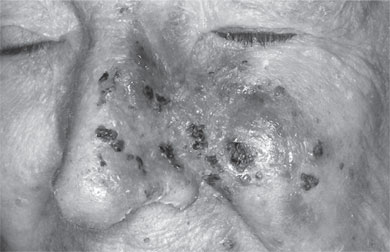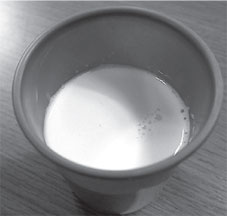|

Researchers develop laser technology to fight cancer
Researchers have developed a technology that goes on a “seek and
destroy” mission for cancerous tumors. They have harnessed the power of
lasers to find, map and non-invasively destruct cancerous tumors.
 Christian Parigger, associate professor of physics, and Jacqueline
Johnson, associate professor of mechanical, aerospace, and biomedical
engineering, along with Robert Splinter of Splinter Consultants, have
developed the invention. The technology uses a femtosecond laser, which
means it pulses at speeds of one-quadrillionth of a second. The high
speed enables the laser to focus in on a specific region to find and
acutely map a tumor. Christian Parigger, associate professor of physics, and Jacqueline
Johnson, associate professor of mechanical, aerospace, and biomedical
engineering, along with Robert Splinter of Splinter Consultants, have
developed the invention. The technology uses a femtosecond laser, which
means it pulses at speeds of one-quadrillionth of a second. The high
speed enables the laser to focus in on a specific region to find and
acutely map a tumor.
“Using ultra-short light pulses gives us the ability to focus in a
well confined region and the ability for intense radiation,” said
Parigger.
“This allows us to come in and leave a specific area quickly so we
can diagnose and attack tumorous cells fast.” Once the cancerous area is
precisely targeted, only the intensity of the laser radiation needs to
be turned up in order to irradiate, or burn off, the tumor.
This method has the potential to be more exact than current methods
and to be done as an outpatient procedure replacing intensive surgery.
“Because the femtosecond laser radiation can be precisely focused
both spatially and temporally, one can avoid heating up too many other
things that you do not want heated,” said Parigger. “Using longer
laser-light pulses is similar to leaving a light bulb on, which gets
warm and can damage healthy tissue.”
The technology can be especially helpful to brain cancer oncology
victims. The imaging mechanism can non-invasively permeate thin layers
of bone, such as the skull, and can help define a targeted treatment
strategy for persistent cancer. The method also overcomes limitations
posed by current treatments in which radiation may damage portions of
healthy brain tissue.
It also may overcome limitations of photodynamic therapy that has
restricted acceptance and surgery that may not be an option if not all
carcinogenic tissue can be removed.
“If you have a cancerous area such as in the brain, the notion is if
you see something and take care of it, it won't spread,” said Parigger.
“This treatment overcomes difficulties in treating brain cancer and
tumors. And it has the promise of application to other areas, as well.”
The researchers are working to bring their technology to market with
the University of Tennessee Research Foundation, a non profit
corporation responsible for commercializing the university's
technologies and supporting UT research.
- MNT
Restitution vs apology in forgiveness
People are more likely to show forgiving behaviour if they receive
restitution, but they are more prone to report they have forgiven if
they get an apology, according to new research.
The study underscores the importance of both restitution and apology
and of using multiple measures for forgiveness, including behaviour,
said Jo-Ann Tsang, an associate professor of psychology and
neuroscience.
 “One of the main reasons for using behavioural measures in addition
to self-reporting by individuals is that they can make themselves look
better by only self-reporting, although they don't necessarily intend to
lie,” she said. “And it may be that ‘I forgive you’ is a more conscious
feeling if they receive an apology.” “One of the main reasons for using behavioural measures in addition
to self-reporting by individuals is that they can make themselves look
better by only self-reporting, although they don't necessarily intend to
lie,” she said. “And it may be that ‘I forgive you’ is a more conscious
feeling if they receive an apology.”
In the study, 136 undergraduate psychology students were stationed in
individual cubicles and told that raffle tickets for a $50 gift card
would be given out in three rounds, with 10 tickets per round to be
divided between a participant and a unknown “partner.” They also were
told they might receive a note from the partner.
In the first round, participants were given only two of the 10
tickets split between them and their partners; in the second, they got
nine. Some were told the distributions were made by the partner; others
were told it was by chance.
Some participants received an apology note from their partners on the
second round, saying, “Sorry about that first round. I got carried away,
and I feel really bad that I did that.” Some participants also received
raffle tickets back from their partners in the second round, a form of
restitution.
In the last round, the participants were given the chance to be in
charge of distributions themselves. Researchers examined the links
between apology, restitution, empathy and forgiveness, measuring
forgiveness in two ways: Through behaviour (how many raffle tickets
participants gave to their partners on the third round); and
self-reporting on a questionnaire, with participants telling how highly
they rated their motivation to forgive.
Researchers wrote that “making amends can facilitative forgiveness,
but not all amends can fully compensate for offenses.” Apology may be
needed to repair damage fully, but it may be a “silent forgiveness,”
while restitution without apology may lead to a “hollow forgiveness” in
which the offenders are treated better but not necessarily forgiven.
“The results suggest that if transgressors seek both psychological
and interpersonal forgiveness from their victims, they must pair their
apologies with restitution,” they wrote.
“Apparently, actions and words speak loudest in concert.”
- psychone.net
Ginseng-fortified milk developed to improve cognitive function
American ginseng is reported to have neurocognitive effects, and
research has shown benefits in aging, central nervous system disorders,
and neurodegenerative diseases. The challenges of incorporating ginseng
into food are twofold: it has a bitter taste, and food processing can
eliminate its healthful benefits.
Reporting in the August issue of the Journal of Dairy Science, a
group of scientists has formulated low-lactose functional milk that
maintained beneficial levels of American ginseng after processing. An
exploratory study found the product was readily accepted by a niche
group of consumers.
 “Our goal was to develop low-lactose milk that could be consumed by
the elderly to improve cognitive function,” reports lead investigator S.
Fiszman, “Consumers who were interested in the health benefits of
ginseng rated our product quite highly.” “Our goal was to develop low-lactose milk that could be consumed by
the elderly to improve cognitive function,” reports lead investigator S.
Fiszman, “Consumers who were interested in the health benefits of
ginseng rated our product quite highly.”
Because older people frequently have trouble digesting milk products,
the researchers developed a low-lactose formula. American ginseng was
added, and then the milk was sterilised by ultra-high temperature
processing (UHT), which prolongs shelf life. Analysis found that
sufficient levels of ginseng remained in the milk after treatment to
improve cognitive function as reported in the literature. To reduce the
bitter taste of ginseng, the investigators developed samples with
vanilla extract and sucralose, a zero-calorie artificial sweetener. In a
preliminary study, 10 tasters with a good ability to discriminate
between flavors compared low lactose UHT milk without any additives (the
control) to low lactose milk with ginseng extract, vanilla aroma, and
sucralose added before UHT treatment.
They developed a list of 10 attributes that described the sample:
colour, sweet odour, milk flavor, vanilla flavour, metallic/root
flavour, sweetness, bitterness, aftertaste, astringency, and viscosity.
They then rated the intensity of each attribute for five samples; the
control; the control with ginseng extract, vanilla aroma, and sucralose
added; the control with ginseng extract added; the control with vanilla
and ginseng extract; and the low lactose milk with ginseng extract;
vanilla aroma; and sucralose added before UHT treatment. In a second
study, 100 participants were asked, on a scale of one to five, how
willing they would be to consume a “highly digestible semi-skimmed
milk,” and a “highly digestible semi-skimmed milk enriched with ginseng
extract that would improve cognitive function.”
Then, they tasted and rated, on a scale of one to nine, the overall
acceptability of the control milk and the low lactose milk with ginseng
extract, vanilla aroma, and sucralose added before UHT treatment. Both
the presence of ginseng and the thermal treatment affected some sensory
properties of the milk. The addition of ginseng significantly increased
the perceived light brown colour in the flavoured and unflavoured
samples, and was highest in the reduced-lactose milk with ingredients
added before the UHT treatment.
The sweet odour was more intense in flavoured samples, but decreased
slightly in the samples of milk with ingredients added before UHT
treatment. Bitterness was clearly perceived in the samples containing
ginseng additives, but was lower in flavoured samples, indicating that
the vanilla aroma and sucralose masked, to some extent, the bitter taste
caused by ginseng extract.
Consumer responses varied greatly, depending on interest in the
product. 78 p.c. indicated that they would be likely to consume the
highly digestible milk, and after tasting the product, 87 p.c. of them
indicated they would buy the sample. 47 p.c. indicated they were not
interested in milk enriched with ginseng, and after tasting, they gave
it a low acceptability rating.
However, for the 32 p.c. of consumers who did express an interest in
the product, 75 p.c. declared they would buy it. “Drinking 150 to 300 mL
of this ginseng-enriched milk would provide the amount indicated to be
effective for improving cognitive functions. Combined with the low
levels of lactose, this makes the drink an appropriate functional
beverage for the elderly,” says Dr. Fiszman. “Among consumers more
likely to consume ginseng products, the newly developed milk was well
accepted. The addition of more congruent flavours such as chocolate,
citrus, or coffee, could be more effective in masking non-milk-related
sensory attributes, Other alternatives could be investigated.”
Commenting on the studies, Susan Duncan, professor, Department of
Food Science Technology, Virginia Tech, noted, “With the combination of
intrinsic health benefits in milk and these additional ingredients, milk
becomes an easy way to deliver valuable functional ingredients and the
functional benefits of milk components. Diversifying the product line
for milk and dairy products has a number of benefits, including market
and consumer visibility and perception.
- esciencenews
How the brain focuses on what's most useful
Ever wondered how the human brain, which is constantly bombarded with
millions of pieces of visual information, can filter out what's
unimportant and focus on what's most useful?
 The process is known as selective attention and scientists have long
debated how it works. But now, researchers at Wake Forest Baptist
Medical Centre have discovered an important clue. Evidence from an
animal study, shows that the prefrontal cortex is involved in a
previously unknown way. The process is known as selective attention and scientists have long
debated how it works. But now, researchers at Wake Forest Baptist
Medical Centre have discovered an important clue. Evidence from an
animal study, shows that the prefrontal cortex is involved in a
previously unknown way.
Two types of attention are utilised in the selective attention
process - bottom up and top down. Bottom-up attention is automatically
guided to images that stand out from a background by virtue of colour,
shape or motion, such as a billboard on a highway. Top-down attention
occurs when one's focus is consciously shifted to look for a known
target in a visual scene, as when searching for a relative in a crowd.
Traditionally, scientists have believed that separate areas of the
brain controlled these two processes, with bottom-up attention occurring
in the posterior parietal cortex and top-down attention occurring in the
prefrontal cortex.
“Our findings provide insights on the neural mechanisms behind the
guidance of attention,” said Christos Constantinidis, associate
professor of neurobiology and anatomy at Wake Forest Baptist and senior
author of the study. “This has implications for conditions such as
attention deficit hyperactivity disorder (ADHD), which affects millions
of people worldwide. People with ADHD have difficulty filtering
information and focusing attention. Our findings suggest that both the
ability to focus attention intentionally and shifting attention to
eye-catching but sometimes unimportant stimuli depend on the prefrontal
cortex.”
In the Wake Forest Baptist study, two monkeys were trained to detect
images on a computer screen while activity in both areas of the brain
was recorded. The visual display was designed to let one image “pop out”
due to its colour difference from the background, such as a red circle
surrounded by green. To trigger bottom-up attention, neither the
identity nor the location of the pop-out image could be predicted before
it appeared.
The monkeys indicated that they detected the pop-out image by pushing
a lever.
The neural activity associated with identifying the pop-out images
occurred in the prefrontal cortex at the same time as in the posterior
parietal cortex.
This unexpected finding indicates early involvement of the prefrontal
cortex in bottom-up attention, in addition to its known role in top-down
attention, and provides new insights into the neural mechanisms of
attention.“We hope that our findings will guide future work targeting
attention deficits,” Constantinidis said.
- MNT
Fear and anxiety alter choices
Anxiety disorders affect approximately 40 million US adults each
year, and although they are treatable, they often cause significant
distress.
 The excessive fear and dread that accompanies anxiety disorders
clearly influences the everyday decision-making processes of anxious
individuals. Despite its importance, “there is surprisingly little
research on how anxiety disorders influence decisions,” said
neuroscientist Dr. Elizabeth Phelps, who co-authored this new review
with Dr. Catherine Hartley, both of New York University. The excessive fear and dread that accompanies anxiety disorders
clearly influences the everyday decision-making processes of anxious
individuals. Despite its importance, “there is surprisingly little
research on how anxiety disorders influence decisions,” said
neuroscientist Dr. Elizabeth Phelps, who co-authored this new review
with Dr. Catherine Hartley, both of New York University.
Their review highlights that science is “starting to gain some
traction by combining emerging decision science with the study of
anxiety.
The overlap in the neural systems underlying anxiety and
decision-making provides some insight into how fear and anxiety alters
choices,” explained Dr. Phelps. Dr. Hartley added, “Historically,
research has focused on the influence of anxiety on how we attend to and
interpret events. These same processes should shape how anxious
individuals make decisions.”Their review explores the role of anxiety in
decision-making using a neuroeconomic approach. Neuroeconomics is an
interdisciplinary field that combines tools from the fields of
economics, neuroscience, and psychology to study the brain's
decision-making processes.
The authors discuss the overlap between the neural systems mediating
fear and anxiety and those implicated in studies of economic
decision-making.Neuroeconomics research has revealed that circuits
involving the amygdala, insular cortex, and prefrontal cortex are
involved in tasks with uncertainty or loss.
The amygdala is a key brain region that helps regulate fear and
anxiety, while the prefrontal cortex is critically involved in the
control of fear.The authors also review a set of decision-making biases
exhibited by anxious individuals and propose that the neural circuitry
supporting fear learning and regulation may mediate anxiety's influence
upon their choices.
“Hartley and Phelps provide an elegant example of how reward-related
decision making may be affected by other neural circuitries, in this
case the emotional processing system,” commented neuroeconomics experts
Drs. Carla Sharp and P. Read Montague. “This is without a doubt part of
the future of the application of neuroeconomics to psychiatric disorder,
as no example of psychiatric disorder can be reduced simply to
reward-related decision making.
- MNT
|

